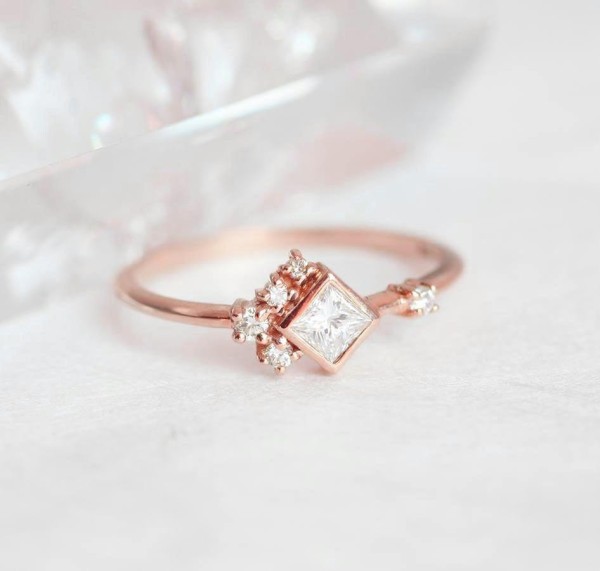
The world of engagement rings is filled with options. From traditional solitaires to bold vintage styles, every choice speaks to personal taste and holds symbolic meaning. Among these, the princess-cut diamond ring has remained one of the most consistently popular styles. Known for its clean lines and sharp angles, the princess cut offers a contemporary twist on a classic look.
In this post, we’ll explore what defines the princess cut, how it compares to other shapes, its history, and what makes it such a sought-after option.
What Is a Princess Cut Diamond?
Theprincess cut diamond is a square or slightly rectangular diamond with pointed corners and a faceted arrangement that maximizes sparkle. Technically, it is a modified brilliant cut, meaning it retains much of the brilliance of a round diamond, but in a geometric, square shape.
It typically has 57 or 76 facets, depending on the specific cutting style. These facets are strategically placed to reflect light from many angles, giving the diamond a bright and lively appearance. Its distinct square shape sets it apart from traditional round brilliants while still offering high light performance.
A Brief History of the Princess Cut
The princess cut is a relatively new diamond shape. It first gained attention in the 1960s and became more widely recognized in the 1980s. Unlike older cuts such as the cushion or emerald, the princess cut was created with modern techniques to retain more of the original rough diamond during cutting. This makes it a more efficient cut from a production standpoint, which has contributed to its availability and popularity.
Comparing the Princess Cut to Other Shapes
What makes the princess cut diamond ring visually striking is its balance between sharp edges and internal fire. The square shape gives it a clean, architectural feel, while the brilliance comes from its multiple facets. For those who want a ring that looks both structured and radiant, the princess cut is often a strong contender. The princess cut is sometimes compared to square cushion cuts or emerald cuts, but the differences are noticeable.
● Cushion-cut diamonds have rounded corners and a softer, vintage look. They also tend to have less sparkle in comparison.
● Emerald cut diamonds have step-cut facets and a large, open table that produces a hall-of-mirrors effect rather than traditional sparkle.
● Asscher cut diamonds are also square but have cropped corners and a more defined Art Deco aesthetic.
In contrast, the princess cut emphasizes fire and brilliance while keeping a more modern, angular outline.
Choosing the Right Setting
Because of its pointed corners, the princess cut diamond benefits from protective settings. Prongs are often placed at each corner to guard against chipping, which is the most vulnerable part of the stone.
Here are a few popular settings for princess cut diamond rings:
● Solitaire: A timeless choice that keeps the focus on the center stone.
● Halo: Adds a ring of smaller diamonds around the princess cut for extra sparkle.
● Three-Stone: Flanks the princess cut with smaller side stones, often in complementary shapes.
● Channel Set Band: Ideal for adding princess cut side stones flush with the band, creating a clean, geometric look.
When choosing a setting, it’s important to consider not only style but also how the ring will be worn daily. A well-secured setting can help preserve the beauty of the diamond over time.
Things to Consider When Buying a Princess Cut Diamond
Like any diamond, a princess cut is evaluated based on the four Cs: cut, color, clarity, and carat. However, there are a few unique considerations for this shape.
● Cut: There is no standardized cut grading for princess cuts as there is for round brilliants. Instead, it’s important to look for symmetry, proportions, and how evenly the facets reflect light.
● Clarity: Due to its faceting style, inclusions may be easier to spot in a princess cut than in some other shapes. It’s often recommended to choose a clarity grade where imperfections are not visible to the naked eye.
● Color: The shape can show color more easily in the corners. Choosing a slightly higher color grade can ensure a whiter appearance, especially if the setting is white gold or platinum.
● Carat Weight: Because the princess cut retains more of the original diamond rough, it often appears smaller face-up than a round diamond of the same carat. It’s worth comparing millimeter measurements rather than just carat weight when choosing between options.
Popular Uses Beyond Engagement Rings
While the princess-cut diamond ring is most often associated with engagement, the cut is also used in other types of jewelry. Princess-cut diamonds are common in earrings, pendants, and even eternity bands, where their square shape allows them to sit flush next to one another without gaps.
Capucinne’s Approach to Princess Cut Rings
Among the brands that offer modern takes on the princess-cut diamond ring, Capucinne stands out for its custom and handcrafted approach. Known for working closely with clients to bring their vision to life.
Their designs often feature ethically sourced diamonds and alternative gemstones in personalized settings. While their collection includes a wide variety of styles, their princess cut designs reflect a thoughtful balance between clean geometry and fine craftsmanship.
Who Is the Princess Cut For?
There’s no single type of person that a princess cut diamond suits best. But certain characteristics often appeal to individuals who gravitate toward this shape:
● Appreciation for clean, structured lines
● Preference for modern design over vintage styles
● Desire for brilliance without the common round shape
● Interest in symmetry and balance
Because it bridges the gap between classic sparkle and contemporary form, the princess cut has broad appeal, and it works just as well for someone who wants something timeless.

